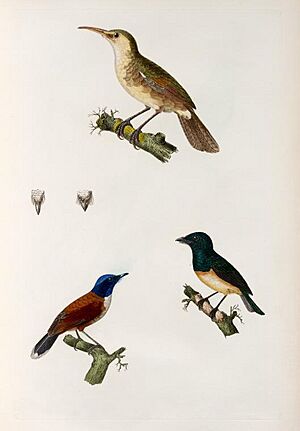Nightingale reed warbler facts for kids
Quick facts for kids Nightingale reed warbler |
|
|---|---|
 |
|
| Nightingale reed-warbler (top) | |
| Conservation status | |
| Scientific classification | |
| Synonyms | |
|
The nightingale reed warbler (Acrocephalus luscinius), also called the Guam reed-warbler, was a small songbird. It lived only on the island of Guam in the Pacific Ocean. Sadly, this bird is now extinct, which means there are no more left alive anywhere in the world. It was last seen in 1969.
Contents
About the Nightingale Reed Warbler
The nightingale reed warbler was first described by two French scientists, Jean Quoy and Joseph Gaimard. They found a specimen of the bird on Guam in 1832. For many years, other similar birds from nearby islands were thought to be the same species. However, in 2011, experts decided that the Pagan reed warbler, Aguiguan reed warbler, and Saipan reed warbler were actually different species.
Why the Nightingale Reed Warbler Disappeared
The nightingale reed warbler became extinct because of several problems. Many of these problems were caused by animals and plants brought to Guam by people.
Introduced Predators
The biggest threat was the brown tree snake (Boiga irregularis). This snake is not native to Guam. It has caused many bird species on the island to disappear. Other animals brought to Guam also hunted the warblers. These included rats (Rattus species), cats (Felis catus), and even wild goats (Capra hircus) or sheep (Ovis aries). These animals ate the birds or their eggs.
Habitat Loss and Other Threats
An introduced plant called ivy gourd (Coccinia grandis) also caused problems. It grew over the trees where the warblers built their nests. This destroyed the birds' homes.
Other human activities also hurt the birds. Places where the birds lived, like wetlands, were destroyed. Fires and pesticides also harmed the environment. More land was used for farming and buildings. All these changes made it harder for the nightingale reed warbler to find safe places to live and raise its young. The last time anyone saw a nightingale reed warbler was in 1969.
Reproduction and Nesting
The nightingale reed warbler did not migrate. It stayed on Guam all year round. These birds would build their nests and lay eggs throughout the year. A typical nest had two eggs. The eggs were white with a slight green color. They also had spots of lavender, chestnut, and black.


